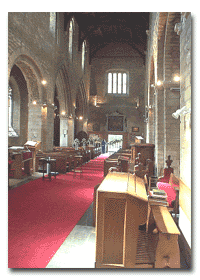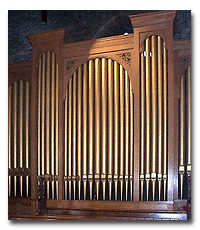|
The Organ of Elstow Abbey by Dr. John Crookall  The Nave and organ console Standing towards the east end of the north isle of our magnificent and resonant Norman Abbey Church, the organ creates a distribution of musical sound throughout the Church which is excellent. Perhaps the organ’s best qualities can be described as having a beautiful tone with a warmth of expression, an ideal musical support for the choir and congregation. The detached console places the organist in an ideal visual position to lead both choir and congregation for services. The organ was built in 1939 by William Hill & Son and Norman & Beard Limited, London, with electro-pneumatic action. When installed it was a new organ replacing an earlier organ, but from which some of the old stops were retained. The previous organ had been by that time about 100 years old, being a 1-manual barrel organ by J W Walker installed c1845, having a “Churchwarden Gothic” case, and which was converted to manual operation in 1868. The present Hill, Norman & Beard organ is enclosed in an attractive 1930’s light oak case, having gilded front show pipes with French mouths, and arranged within five round-headed arches. The organ case was designed by Peter Hartley, a student at the Slade School of Art and son of the then Vicar of Elstow, the Rev. Stanley Hartley. The Bedford firm of C A White built the organ case, and at that time also constructed much of the furnishings, namely the Altar, Lectern, Clergy Stalls, etc. Peter Hartley suffered subsequently as a Far Eastern Prisoner of War. After the war he returned to Elstow, wrote a book about his experiences, and studied for the ministry. Following the death of his father in 1953 he became vicar at Elstow. In 1976 he was appointed Canon Residentiary of Bermuda Cathedral. Peter died in 1992 and is buried in Elstow Churchyard. The organ sounds very fine. It has been described as having the rich subtlety of a cathedral organ. All ranks of pipes are full compass and speak well within their intended total range. The organ console with its tab-stop layout is comfortable to play, the keys  Organ case and display pipes behind the north-side choir stalls being of ivory, which provides the best touch quality for the organist (nowadays ivory is available only by reusing old keys). Nicholson & Co. cleaned and overhauled the organ in 1972, and some water damage occurred in 1979. Further reports and estimates were sought in 1985- 86 from organ builders, and two in particular offered extensive and practically needed replacement of electrical components, leather work, console parts, etc. and also proposed major tonal developments. Cost, however, precluded the latter, and after much deliberation a more modest scheme was approved covering the necessary restoration, cleaning and overhaul in 1992. The organ builder chosen for the work was E J (William) Johnson & Son of Cambridge. Aspects requiring correction included corrosion of pedal magnets, where dampness and half a century’s use had taken their toll. The cost of this reconditioning amounted to some £23,000. The Elstow Abbey organ specification is recorded in the National Pipe Organ Register in Cambridge.
Dr. John Crookhall was organist and choir master at Elstow Abbey for many years. John died in November 2013. |



